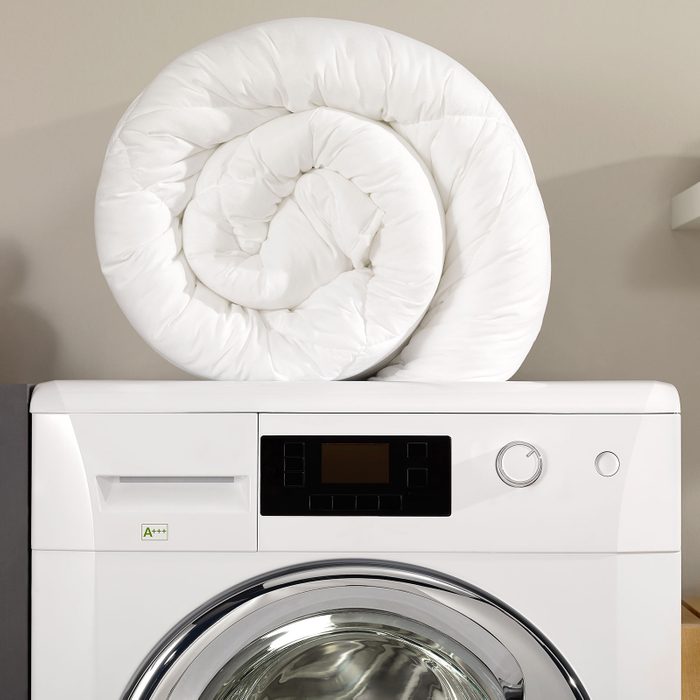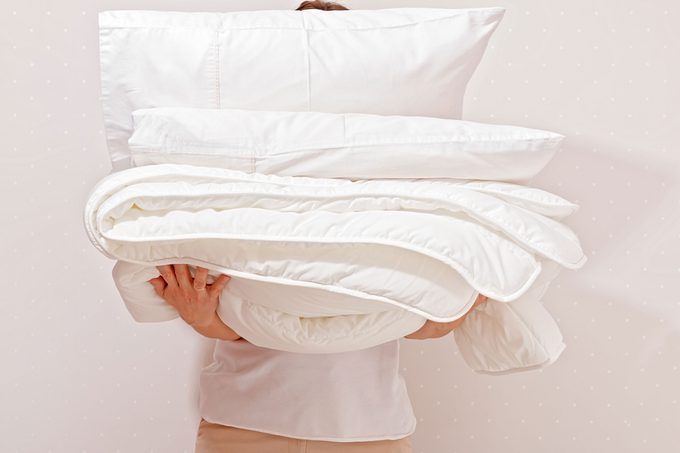How to Wash a Down Comforter

Some of your bedding needs some special TLC! Skip the most common mistakes with these tips on how to wash a down comforter at home.
Your regular washing schedule includes your bedding, but while sheets and throws are a cinch to clean, things get trickier when tackling bulkier items, such as large quilts. In the colder months, you may be using a cozy down comforter, which doesn’t need washing as frequently as other bedding items—you should wash your sheets every week—but still requires some careful attention now and then. But you shouldn’t be too rough or careless when washing a down comforter—if you don’t care for yours properly, you may end up with a lumpy, bumpy mess.
Because traditional down comforters are filled with the down feathers of geese or ducks, the feathers can bunch up and flatten when washed due to moisture and soap residue, and it’s not fun trying to spread them back out. Even if you have a down alternative comforter, which is typically filled with polyester or rayon, you may still experience some unwanted bunching. Luckily, if you know how to wash a down comforter properly, you shouldn’t have any problems. It’s easier than you’d think!
How to Wash a Down Comforter
Per appliance brand Whirlpool, you should wash your comforter two or three times a year if you use a duvet cover. Keeping a duvet cover or sheet over your comforter will keep it cleaner longer, and you can launder the cover more regularly. If you don’t keep a cover on your comforter, you should wash it every couple of months.
Other experts list a longer period of time between washes. For example, sleep experts at the Sleep Foundation state you may only have to wash a down comforter one to two times per year if you keep a duvet cover on it. Since down comforters are delicate, only wash yours when it needs it. If your down comforter is brand new, Whirlpool argues against using it straight out of the package due to the potential presence of “trace chemicals” or other irritants from the manufacturing process.
Washing a down comforter, also called a duvet insert, requires a few mindful steps:
- Check the care label: Before you launder your down comforter, check its care label. If your comforter has especially delicate fabric (like silk) and the tag recommends having it laundered at a dry cleaner, then you should take it to a local cleaner. If the label has at-home care instructions, you’re good to go.
- Repair rips: Next, look for any rips or tears that would cause its filling to come out in a wash cycle. Sew those up if you find any.
- Treat any stains: Spot-check your comforter for any stains. You should pre-treat stains with a stain-removing solution. If you find blood stains or pet urine stains, use an enzymatic cleaner to treat those. When spraying your stains, lift the fabric of the comforter away from the fill and let it sit for at least 10 minutes.
- Load it into the washing machine: If you’re using your washing machine, check that it has enough room to handle bulky loads. If it fits well, you’re in the clear. Make sure it isn’t bunched up on itself.
- Put your detergent in: Select a mild detergent. You may want to find a down-specific detergent. Less is more for your down comforter.
- Fix your settings: Use your washer’s gentle or delicate cycle with warm water (not hot) and an extra rinse cycle to ensure all the detergent residue gets rinsed out.
- Run and wait: Once it’s washing, wait for it to finish its full cycle.
You can also wash a down jacket at home following similar steps.
How to Dry a Down Comforter
How you dry your comforter is just as important as how you wash it. Follow these steps carefully to complete your laundering cycle:
- Make sure your comforter has enough room in your dryer: You want it to dry completely to avoid mildewing. Down feathers have a specific scent when wet, so don’t be alarmed by the strong smell.
- Set your drying setting to low or delicate: Odds are, your instincts will be to use a high dryer setting, but if your dryer gets too hot, it can damage the down feathers.
- Stop your dryer every so often: Between your drying cycle, open your dryer to break up your comforter’s lumps. You may also want to add wool dryer balls, which can speed up the drying process. Take it out of the dryer and shake it every half-hour or so to help keep the clumps at bay.
- Be patient: It can take a few hours for your down comforter to completely dry. Down comforters are bulky, so a slow drying process is normal.
Things to Keep in Mind
Other things you should know to ensure your success:
- Most experts don’t recommend air-drying your down comforter due to the increased risk of mildew.
- Avoid dry cleaning—the harsh chemicals can damage your down comforter. If you need an expert cleaner, ask your local dry cleaners if they can launder the item, not dry-clean it.
- Because down comforters are at risk of mildew, you must make sure your comforter is completely dry. If mildew or mold takes hold, breathing it is dangerous, so you should take your comforter to an expert cleaner if this occurs.
- Don’t use too much detergent. It can coat the feathers and cause them to flatten and clump together.
- Don’t use any fabric softener. Fabric softener residue will cling to the comforter’s fill and, again, cause clumping and loss of insulation.
- Don’t let your dryer get too hot—check the temperature during your comforter checks to keep it from damaging the fill.
Down comforters aren’t the only items that require special care. Check out these laundry tips for hard-to-wash items. If you struggle to launder your clothes and are tired of shrinking and damaging your favorite pieces, read these laundry tips for washing your clothes, including how to fix shrunk T-shirts.




